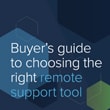
 Free 14-day trial
Free 14-day trial

Remote Support Buyer's Guide
Know what to look for when selecting the right remote support tool for your company.

Remote support is the action of providing technical support once a remote access connection is established for the specific purpose of troubleshooting and solving technical issues. Remote support includes remote computer support for PCs and Macs, or remote mobile support for iOS, Android, and Windows smartphones and tablets.
Before remote support technology, help desks and call centers provided customer support over the phone, email or through chat. End users described the problem, technicians tried to figure out what was going on, and customers executed step-by-step instructions for possible remedies. But these interactions were time consuming and frustrating for end users and technicians alike.
That all changed with remote support software. By letting customers give permission for technicians to set up a remote access connection to their device, remote support software dramatically accelerated the support process and reduced frustration in the support process.
Remote support software allows technicians to view, control and run diagnostics on a remote device without asking the user to do anything. They can transfer files, configure settings, troubleshoot issues, and resolve problems on their own.
This is clearly a better experience for the customer or employee, who can sit back while the technician solves their issue. But it’s also a better experience for the technician, especially with the right remote support platform that makes their jobs easier. By temporarily taking control of the device, agents can work with it as if it was sitting on the desk in front of them to work more quickly and productively. So remote support software can be leveraged to increase agent productivity as well as improve the overall experience for the end user on the customer’s or employee’s side.
There are several types of technologies that support teams use for remote support.
Getting a little more granular, it may help to understand the differences between attended and unattended remote support; the distinction is whether there is someone on the other side of the session.
Agents can provide, and customers can receive, remote assistance for a number of devices in various ways. Remote assistance works for connected devices like desktop and mobile devices, disconnected devices like equipment and printers with Rescue Live Lens camera-sharing, and web support. Remote assistance covers varying degrees of assistance, including remote view, remote control, file sharing, camera-sharing, and co-browsing.
Remote assistance isn’t limited to technical support. Customer service teams can provide remote assistance in many ways, including walking customers through digital experiences with co-browsing and providing warranty support and product demonstrations with camera-sharing. These visual engagement solutions allow organizations to provide concierge-level CX at a distance.
A remote connection specifically refers to the action of connecting to a remote support session. Any remote connection should be secure, especially for organizations offering remote support sessions to customers or employees or for providers of remote access software. All connections should have the same level of security used by financial institutions, including TLS 1.2 transport security with AES-256-bit encryption.